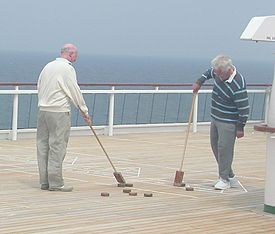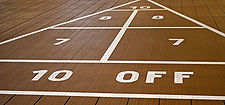- Shuffleboard
-
"Shuffleboarding" redirects here. For the episode of SpongeBob SquarePants, see Shuffleboarding (SpongeBob SquarePants).
Shuffleboard, more precisely deck shuffleboard, and also known as shuffle-board, shovelboard, shovel-board and shove-board [archaic],[1] is a game in which players use broom-shaped paddles to push weighted pucks, sending them gliding down a narrow and elongated court, with the purpose of having them come to rest within a marked scoring area. As a more generic term, it refers to the family of shuffleboard-variant games as a whole.
Contents
History
The full history of shuffleboard is not known. Though there is some knowledge of its development, its actual origins, the place and date where it was first played, remain a mystery. Inevitably, this uncertainty gives rise to some debate, even disagreement, about which country can claim to have invented it. However there is no dispute concerning its age as a form of popular amusement, and in Europe has a history that goes back over 500 years.
The game was played and gambled over by King Henry VIII of England, who prohibited commoners from playing; evidently he did not always win, as the record of royal expenses for 1532 show a payment from the Privy Purse of GB£9, 'Paied to my lord Wylliam for that he wanne of the kinges grace at shovillaborde' (contemporary spelling: 'Paid to Lord William, for he won, by the king's grace, at shovelboard').[1]
In its goals, form and equipment, shuffleboard shares various features with (and perhaps influences by or upon) many other games, including air hockey, bowls, bocce, curling, croquet, carrom and billiards. Historically, the ancient shovelboard, about which little is known, appears to have diverged into modern shuffleboard and sjoelen,[1] and with the former leading to the development of both table shuffleboard and shove ha'penny.[1][2]
Today, due to its popularity on cruise ships and in retirement homes because of its low physical fitness requirements, the deck game is often associated with the elderly, though its miniaturized tabletop variant is increasingly popular in bars and pubs among younger generations.
A National Shuffleboard Hall of Fame (NSHF) was established in the United States in 1995, with the goals of recognizing excellence among participants in shuffleboard and to preserve the history of the game.[3]. Twelve people have been inducted {{as of|2006}: (California) PeeWee Ramos, Bob Miles, Billy Chiles; (Oklahoma) Bill Melton, Glen Davidson; (New Jersey) Mickey Mickens, Sol Lipkin; (Texas) Earl Kelly; (Nebraska) Denny Busch; (Pacific Northwest) Jim Foran.
Game play
In deck shuffleboard, the player uses a stick, called a tang, to push weighted disks, called biscuits, along a usually wooden surface (e.g. the deck of a ship), placing the disk within a triangular scoring zone at the far end of the court. This is commonly referred to as "sending the biscuit." The pinnacle of the triangle points toward the shooter, and the zone is divided horizontally into four numbered sub-zones, the numbers representing point values. If the biscuit lands completely within the small triangular tip zone without touching any part of the borders of the triangle, it is worth ten points; completely within the trapezoidal second tier of the triangle, it is worth eight points; and completely within the trapezoidal third tier of the triangle, seven points. If the biscuit lands in the large, rearmost and also trapezoidal '10 Off' section, it costs minus ten points. Many boards have a small triangle drawn in the center of the '10 off' trapezoid, splitting it and making it harder to land completely inside the section. The game is played in matches of ten frames (a frame is both players or teams taking their turns). The basic strategy involves deflecting the opposition's biscuits out of zones with a positive value, and increasing one's own points by landing disks into areas of a high point value.
A standard deck shuffleboard court is 39 feet (12 m) long by 6 feet (1.8 m) wide. Each end of the court has a scoring triangle, obviating the need to retrieve the pucks and return to the original end of the court. Another 6 feet of space is provided at each end of the court beyond the scoring triangles, which is where the players stand, with play alternating in direction down the court after each frame.
Newer courts are now available, for use on decks or on any solid flat surface, in the form of roll-out plastic mats, or an adjustable system of plastic tiles. With the tile courts, the dimensions can be adapted to the space available; e.g. it is possible to play on a court 30 ft long (9.1 m) by 5 ft wide (1.5 m).[citation needed] The roll-out mats are available in two sizes, 39 by 6 feet (12 × 1.8 m) and 27 by 4.5 feet (8.2 × 1.4 m). The smaller mats are designed to fit on a domestic patio or driveway.[citation needed] The biscuit and tang are the same standard size, regardless which court size is used.[4]
Teams
Shuffleboard can be played either one-on-one or by two teams of two. After all biscuits have been sent on one 'end', only the winning biscuit or group of biscuits (a "basket") scores (according to the points marked on the board). Play then continues in the opposite direction. The winner is the first to a set number of points. During tournament play, discussion between teammates is strictly forbidden, to discourage cheating.
World championships
The 2009 World Championships in Deck Shuffleboard (Singles World Cup) took place in Zephyrhills, Florida in the United States on October 14 through 18 2009, run by the International Shuffleboard Association (ISA).[5] The 2009 world champions are Jim Bailey (US) in the men's division and Sachiyo Takada (Japan) in the women's division. Current team world champions are USA (men) and Canada (women).[6] Both won their title 2010 at the 28th Team World Cup in Hohenroda in Germany.
The ISA was founded March 10, 1979, in St. Petersburg, Florida. The ISA was designed to make shuffleboard more popular in countries outside the North American continent, and to foster shuffleboard through international competitions. In 1981 in Muskegon, Michigan the first ISA Team World Championships were held, starting with teams from Canada, the USA and Japan only. Australia (1991), Brazil (1996) and lately Germany (2005) started National Associations and joined the World Championships, which take place yearly and last for one week.
Table shuffleboard variants
In table shuffleboard, the play area is most commonly a wooden or laminated surface covered with silicone beads (colloquially called 'shuffleboard wax') to reduce friction. In the United States, a long, narrow 22 ft table is most commonly used, though tables as short as 9 ft are known.
Players try to slide metal-and-plastic pucks, sometimes called weights or shuckles, to come to rest within zones at the other end of the board. Cues are not used, the pucks being propelled with the hands directly on the raised table. There are scoring zones at each end of the table so that direction of play can rotate after each frame, or so that teams can play both directions during one frame. More points are awarded for weights scoring closer to the far edge of the board. Players take turns sliding the pucks, trying to score points, bump opposing pucks off the board, and/or protect their own pucks from bump-offs. The long sides of the table are bounded by gutters into which pucks can fall or be knocked (in which case they are no longer in play for the remainder of the frame). A variant known sometimes as bankboard has rubber cushions or 'banks' running the length of both sides of the table, instead of gutters, and as in billiards, the banks can be used to gain favorable position. A common and even smaller-scale British tabletop variant is shove ha'penny, played with coins, while a somewhat larger wooden-puck variant called sjoelen, which has much in common with the ball games bagatelle and skeeball, is played principally in the Netherlands.
Object of the game
The objective of the game is to slide, by hand, all four of one's Weights alternately against those of an opponent, so that they reach the highest scoring area without falling off the end of the board into the alley. Furthermore, a player's Weight(s) must be farther down the board than his opponent's Weight(s), in order to be in scoring position. This may be achieved either by knocking off the opponent's Weight(s), or by outdistancing them. Horse collar, the most form of the game, is played to either 15 or, more typically, 21. Below is an image of the weights on the board. Only the weights in front score.[7]
Notes
- ^ a b c d Masters, James (1997). "The Shovelboard Family: History and Useful Information". The Online Guide to Traditional Games. United Kingdom. http://www.tradgames.org.uk/games/ShovelBoard.htm. Retrieved 2007-09-22.
- ^ Masters, James (1997). "Shove Ha'penny: History and Useful Information". The Online Guide to Traditional Games. United Kingdom. http://www.tradgames.org.uk/games/Shove-HaPenny.htm. Retrieved 2007-09-22.
- ^ http://blog.tableshuffleboard.org/2006/03/25/table-shuffleboard-association-hall-of-fame-inductees-as-of-march-25-2006.aspx
- ^ Rules on ShuffleboardEurope.com
- ^ Withers, Wendy. "World's top shuffleboard players to square off this week in Zephyrhills", St. Petersburg Times (October 12, 2009)
- ^ Official website of the 28th Shuffleboard Team World Cup
- ^ "Shuffleboard Table Game Rules"
External links
- International Shuffleboard Association
- German Shuffleboard Association
- Florida Shuffleboard Association
- Table Shuffleboard Information
- Shuffleboard Table Buying Guide
- Table Shuffleboard History Information
- Deck Shuffleboard Official Rules
- Table shuffleboard tournament results
- Short History of Deck Shuffleboard
- Video of Deck/Court Shuffleboard
- Shuffleboard Game Rules
- "Favorite Steamer-Deck Game Now Played on Land" Popular Mechanics, April 1929, bottom page 716
Categories:- Deck sports
- Shuffleboard
Wikimedia Foundation. 2010.




